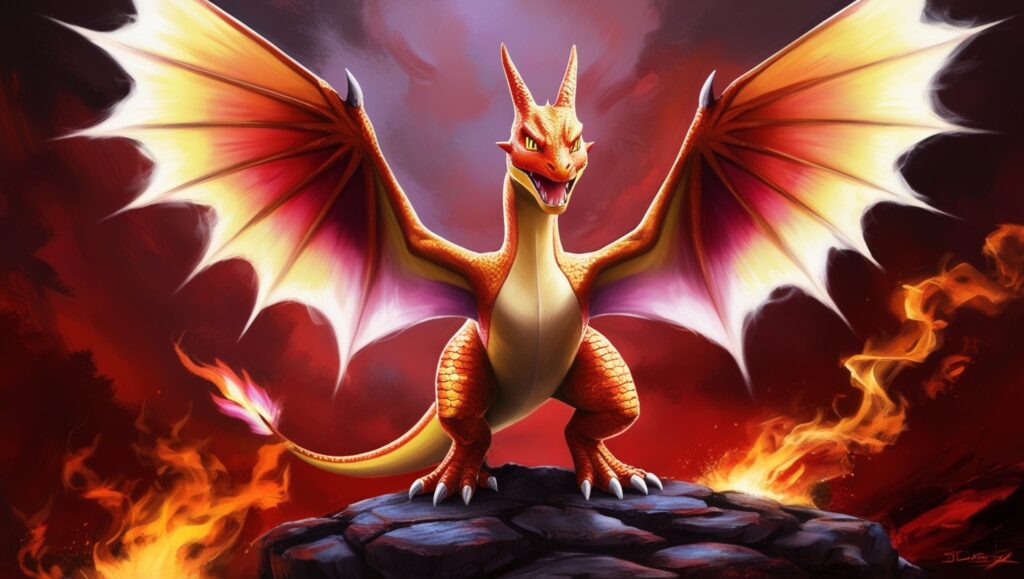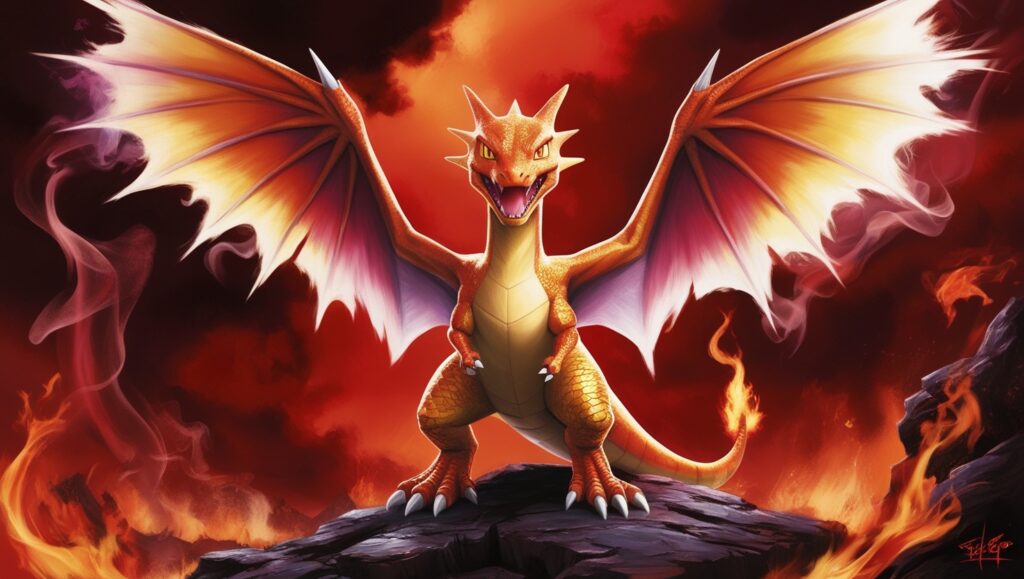Charizard, the fiery dragon-like Pokémon, has captivated fans since its introduction in 1996. As the final evolution of Charmander, Charizard represents a significant milestone in the Pokémon series. This article delves into Charizard’s origin, characteristics, evolution, impact on popular culture, and enduring legacy within the Pokémon franchise.
Origins and Design
The Concept of Charizard
Ken Sugimori, a prominent illustrator and designer for the Pokémon franchise, designed Charizard. Inspired by various mythological creatures and animals, Charizard combines elements of dragons and lizards, featuring large wings, a long tail, and a fierce demeanor. Its design encapsulates the essence of a fire-breathing dragon, embodying both power and grace.
Evolutionary Line
Charizard evolves from Charmander at level 16 and then into Charmeleon at level 36. This evolutionary path symbolizes growth and strength, symbolizing the journey many players undertake as they progress through the games. Charmander’s initial cute and approachable design transforms into the formidable Charizard, showcasing the game’s themes of development and evolution.
Characteristics of Charizard
Type and Abilities
Charizard is a Fire/Flying type Pokémon, making it vulnerable to Rock-type moves while resistant to Bug, Steel, Fire, Grass, Fairy, and Fighting types. Its dual typing offers unique advantages in battles, allowing for diverse strategies. Charizard possesses several abilities, including Blaze, which boosts its Fire-type moves when its health is low, and the hidden ability Solar Power, which increases its Special Attack in sunny weather at the cost of some health.

Moves and Combat Style
Charizard is renowned for its powerful moves, including Flamethrower, Dragon Claw, and Air Slash. These moves reflect its fiery nature and provide tactical versatility in battles. Charizard can be a formidable opponent, utilizing its speed and exceptional attack prowess to overwhelm adversaries. Many trainers favor Charizard for its ability to learn a wide range of moves, making it adaptable to various battle scenarios.
Charizard in Popular Culture
Appearances in Games
Charizard first appeared in the original Pokémon Red and Blue games, quickly becoming a fan favorite. Over the years, it has appeared in numerous games, including spin-offs like Pokémon Snap and Pokémon GO. In Pokémon Sword and Shield, Charizard was given a particular Gigantamax form, further elevating its status within the community. Its game appearances highlight its strength, making it a sought-after Pokémon for competitive battling.
The Anime Influence
Charizard’s prominence in the Pokémon anime cannot be overstated. Ash Ketchum’s Charizard, initially a disobedient Pokémon, evolved into one of his most powerful allies. This dynamic arc resonated with fans, showcasing trust, growth, and friendship themes. Charizard’s fierce loyalty and impressive battles contributed significantly to its popularity, establishing it as a beloved character in the series.

Merchandise and Fan Culture
Charizard has also become a staple in Pokémon merchandise, from toys and cards to clothing and collectibles. Its iconic status is further amplified by the Pokémon Trading Card Game, where it has featured numerous powerful cards, including the highly coveted Charizard holographic card. This card has become a symbol of nostalgia and value within the collector community.
Charizard’s Legacy
Competitive Battling and Tournaments
Charizard has made a significant impact in competitive Pokémon battling. Its versatility, powerful moves, and abilities have allowed it to shine in various formats. Tournaments often showcase Charizard’s capabilities, with trainers employing different strategies to leverage its strengths. Its status in the competitive scene continues to be prominent, with players regularly debating its place in team compositions.

Community and Fan Events
Charizard’s popularity is not just limited to the games and anime; it has become a central figure in Pokémon community events. Fan art, cosplay, and Charizard discussions are typical within Pokémon fandoms. Community events, such as Pokémon tournaments and fan conventions, frequently highlight Charizard through contests, themed activities, and meet-ups, solidifying its place as a cultural icon.
Conclusion
Charizard stands as a testament to the enduring appeal of the Pokémon franchise. From its intricate design and powerful abilities to its rich history in games and media, Charizard has become more than just a Pokémon; it is a symbol of adventure, growth, and community. As new generations of trainers discover the world of Pokémon, Charizard remains a cornerstone of the experience, continually inspiring fans, young and old.
FAQs
What level does Charmander evolve into Charizard?
Charmander evolves into Charmeleon at level 16 and Charizard at level 36.
What type is Charizard?
What are some of Charizard’s most substantial moves?
Some of Charizard’s most substantial moves include Flamethrower, Dragon Claw, and Air Slash.
Why is Charizard so popular among fans?
Charizard’s popularity stems from its robust design, strong combat abilities, a significant presence in the anime, and nostalgic value in the trading card game.
Is Charizard viable in competitive play?
Charizard is often used in competitive battling due to its versatility, powerful moves, and unique abilities that can fit various team strategies.


